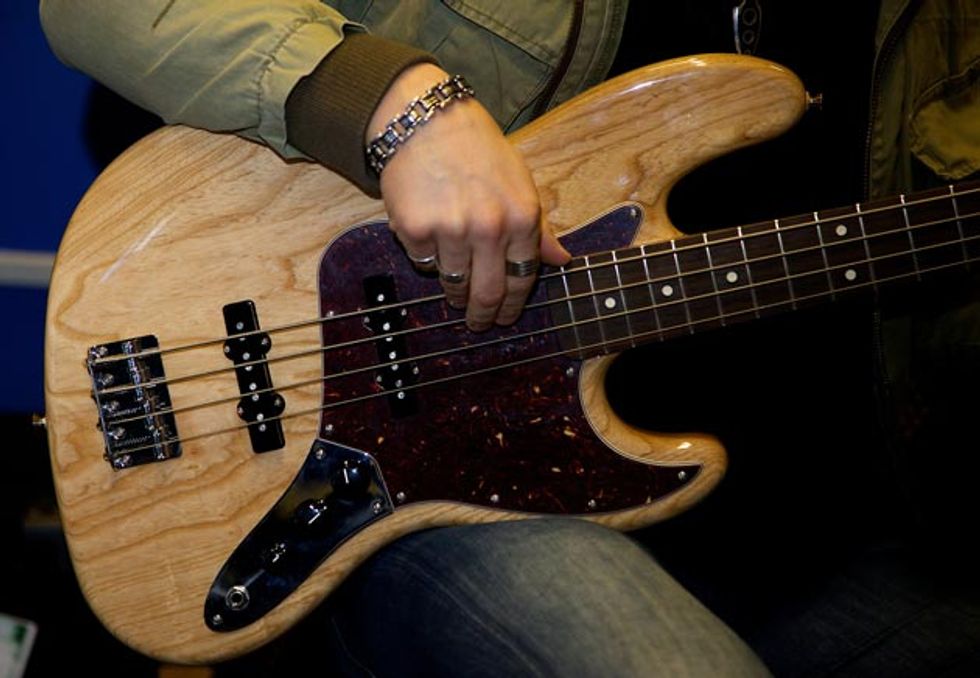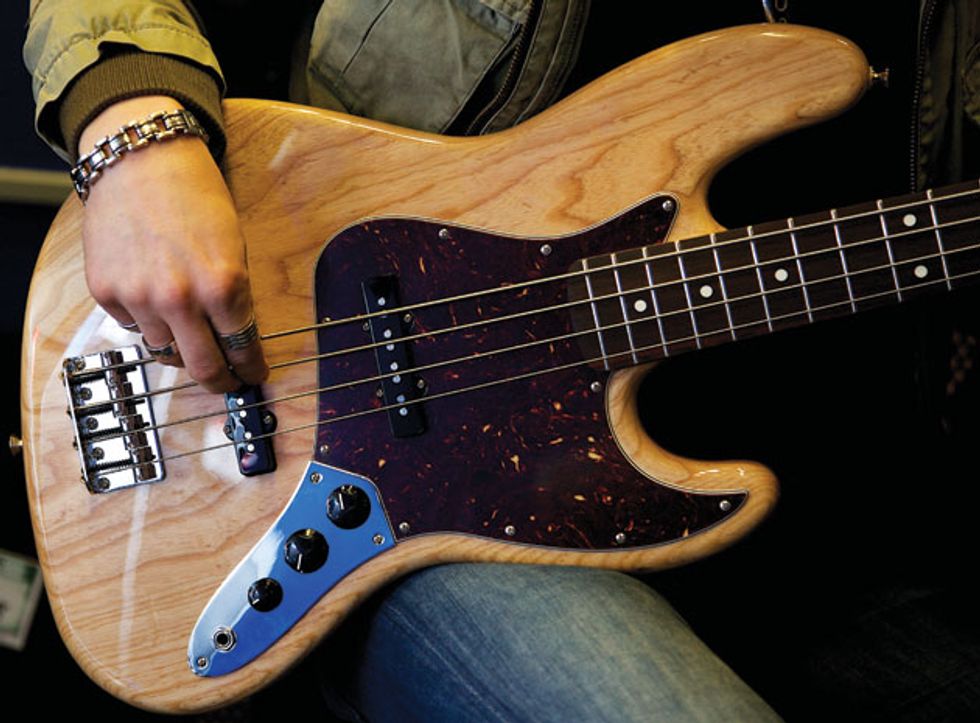In my previous column [“Covering Your Basses,” May 2014], I talked about the importance of being stylistically well-versed and argued the artistic validity of being a jack-of-all-trades and master of none. Owning just one Jazz- or Precision-style passive bass with two pickups, two volume controls, and a tone control will let you play almost all popular styles, without having to change amps or pedals like a guitarist might.
The following tips are simplysuggestions and primarily apply to recording, even though you will also get good results using these settings and techniques onstage with an amp set fairly flat. One bass and a world of musical styles are literally at your fingertips, and this will let you be a several-trick pony!
Reggae
The first order of business here is to set the rear pickup’s volume control to zero. Second, move your plucking hand to a position close to the neck, wherever you feel most comfortable. Many reggae players even put their thumb on top of the neck (Photo 1). To generate the sub lows needed for reggae, dial the tone control all the way off. In addition to the obvious results of taking most upper-mid and treble frequencies out of your bass, it will also remove some low-mid punch that we so love in other styles, but that isn’t necessarily desirable for reggae songs. You can achieve this slow attack and very round sound with a newer set of strings, but an older set that sounds slightly dead is preferable.
that sounds slightly dead is preferable.
Fingerstyle Funk
To attain the staccato attack and midrange definition that are both requirements for this style, you need to rely on your bridge pickup. It will give you the gnarly, well-defined punch that you know from legends like Rocco Prestia and Jaco Pastorius. Personally, I never fully solo the rear pickup. The lack of low end when only using the bridge pickup on a Fender-style bass is too apparent to me, so instead I roll back the neck pickup’s volume to about 40 or 50 percent while keeping the bridge volume dimed.
Depending on what amp or DI you are using, this specific setting might still sound a little bright, but it can be easily remedied by turning down the tone knob. I like to roll it down about halfway when going for this tone. The most important thing from a playing perspective is that you pluck the strings close to the bridge. Anchoring your thumb on top of the bridge pickup works wonders (Photo 2). This setting is very usable for fusion, smooth jazz, emulating fretless-bass sounds, and bringing out harmonics when performing a bass solo.
Rock
To replicate the fat and warm classic-rock tones of the ’70s, I dime the front pickup, set the tone to about 50 percent, and use the bridge pickup at less-than-half volume or not at all. That’s because I like to keep bright, fresh strings on most of my basses and most of the rock tones from that era borrow stylistic cues from the very warm, round R&B tones of the ’60s. If your strings are almost dead, however, leave the tone control wide open for that throwback sound. I rest my thumb on top of the neck pickup, though other guys using this technique frequently play slightly in front of the neck pickup. A word of caution: This tone can get muddy if you are playing in a two-guitar band where the guitarists are using closed-back cabinets or have a lot of volume.
Photo 2 illustrates the perfect midrangey fingerstyle tone requires full volume on the bridge pickup and a playing position close to the bridge.
For great rock tones using a pick, there are a few options. To get a lot of definition or “click” from your pick, leave both pickups on and your tone control wide open, and place your palm on top of—or near—the bridge like a guitarist would. Instead of hitting the string in a sideways motion with the pick on top of the string, make sure you play in a straight-up-and-downmotion (floor to ceiling) while getting the pick almost under the string until the pick itself bends. This technique will cut through those potentially loud, muddy guitars mentioned earlier.
For a slightly looser or sloppy feeling rock-pick approach, keep the tone knob wide open, solo the neck pickup, and strike the strings with a pick directly above the pickup, or slightly in front of it. A lot of punk- and modern-rock tracks feature this tone and it will probably sound very familiar to you, especially on a bass with a maple neck. This tone requires fresh strings and more of a strumming approach as you hit the string.
Most of your favorite albums were likely made with a P- or J-style bass without much else than a DI or a basic amp. Getting to know all the possibilities that live inside your instrument itself will make all other bass gear icing on the cake, rather than a necessity. Go explore! The tone is in your hands.








![Rig Rundown: AFI [2025]](https://www.premierguitar.com/media-library/youtube.jpg?id=62064741&width=1245&height=700&quality=70&coordinates=0%2C0%2C0%2C0)












 Shop Scott's Rig
Shop Scott's Rig















































